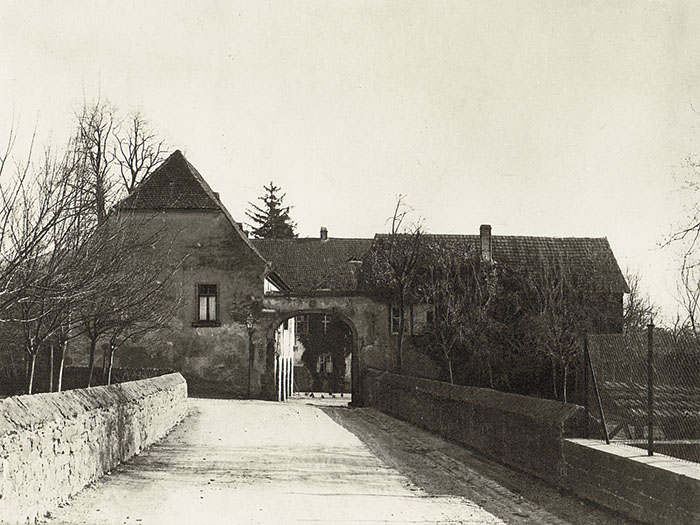 |
 |
 |
The housing complex known as „Atzelhof“ was built between 1921 and 1928 as part of an impressive social housing building programme in Heidelberg. It gets its name from the German word for magpie (“Elstern”) because these birds used to nest in the large poplar trees on this site.

Atzelhof, entrance arch in 1910. View to the south. On the left, the churchyard wall of St.Vitus church and the street Pfarrgasse.
Straight ahead: what is now the street Steubenstrasse.
This decorative archway in the street Pfarrgasse is one of five such archways – two in Steubenstrasse and three in Rottmannstrasse. The other four archways are not intended for traffic but as passageways to the courtyards of the housing complex or for emergency vehicle access. The complex was built over Pfarrgasse, with just a tunnel-like archway, to protect the courtyards from the noise of Steubenstrasse, where the tram used to run.

Yard of Atzelhof with horse trough around 1900. View towards St.Vitus church and Steubenstrasse (opposite direction from photo no.1)
This site has a long history and is closely connected with the mighty abbey of Lorsch. In the year 765, a man called Sigwin from Hantscuesheim gifted a vineyard to the newly formed abbey of Lorsch. This was the very first mention of Handschuhsheim. Many people in other places followed Sigwin’s example and tried to secure heavenly rewards by giving land to Lorsch Abbey. In fact, more gifts were made by people from Handschuhsheim than from any other village or town. Lorsch Abbey therefore needed to build a grange known as Lorscher Hof here on this site in Handschuhsheim to manage these various gifts and leaseholds, and to store and house agricultural goods and animals.
Following the Reformation and the dissolution of the monasteries, the Prince Elector of the Palatinate, Frederick III, founded a state orphanage in 1575 and this was housed in the former Lorscher Hof and funded by the leasehold payments formerly made by the farmers to Lorsch Abbey. The orphanage was looted and damaged repeatedly in the Thirty Years War (1618-1648) and suffered from other wars and religious conflicts in the 17th and 18th century. It was closed in 1813, by which time Handschuhsheim now belonged to the state of Baden. The last director of the orphanage was Karl Franz Joseph Rottmann, the grandfather of the famous landscape and Bavarian court artist Carl Rottmann, Handschuhsheim’s most famous “son”.
The grange was then used for agricultural purposes, with a number of different owners, until the beginning of the 20th century.
At the end of the 19th century, and particularly after World War I, there was a huge demand in Heidelberg for housing for the working classes, people with low incomes and refugees from Alsace-Lorraine. And so the town of Heidelberg started a large building programme for social housing in Pfaffengrund, Bergheim and Handschuhsheim. Several architects worked on the plans for “Atzelhof”, which was built in different stages on the site of the former Lorscher Hof and orphanage. High-quality building materials were used and an extremely attractive architecture for the resulting 220 apartments of different sizes and several shops. This social housing complex with balconies for every apartment, only two apartments per floor in each unit and with leafy courtyards and playing areas for children is quite unique among the social housing developments in Heidelberg at the start of the 20th century. (bm)